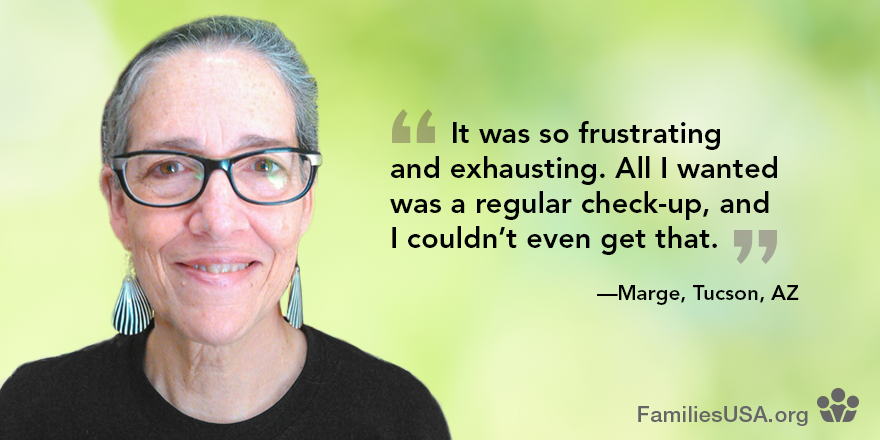
How Inaccurate Health Plan Provider Directories Block Access to Health Care
05.24.2016
As a freelance writer and director of a small nonprofit that provides expressive arts experiences to refugees in Tucson, Arizona, Marge is already very busy. But last year, Marge spent so much time trying to find a primary care physician in her health plan’s network that it began to feel like her third part-time job. Marge spent months calling doctors who were listed in her plan’s online provider directory, but this critical consumer resource proved to be inaccurate.
Marge grateful for protections of the Affordable Care Act
Before the Affordable Care Act (ACA), Marge’s health care woes were much worse. With a preexisting condition on her health record, Marge couldn’t get coverage on the private market. Even though Marge’s husband wanted to retire, he reluctantly stayed at his job so Marge could get coverage through his employer-based insurance.
In 2014, Marge was able to get coverage through the ACA’s health insurance marketplace, and her husband was finally able to retire. During her first year in a marketplace plan, Marge saw a primary care physician and a dermatologist in her network without any trouble.
Relief turns to frustration over finding an in-network doctor
For 2015, Marge’s premium was set to go up, so she shopped around for a better deal on the health insurance marketplace. Soon after enrolling in her new plan, Marge called her primary care doctor to schedule her yearly check-up and a pap smear. According to her plan’s provider directory, her physician from the previous year should have been in her new network, but she was told otherwise when she called the physician’s office. That was just the beginning of Marge’s struggle to find a primary care physician.
Marge pulled up the provider directory on her insurance company’s website and started calling the female primary care doctors. Even though Marge was using the directory for her specific plan, none of the doctors she called took her coverage.
Unfortunately, Marge’s experience isn’t uncommon. According to a Families USA report, inaccuracies in provider directories are prevalent throughout the country in all kinds of insurance plans. These inaccuracies not only lead to headaches for consumers, they also create barriers to consumers’ ability to obtain prompt, affordable care.
Valuable time lost trying to track down an in-network provider
Marge remembers spending three hours one day calling different doctors’ offices listed in the directory to see if they took her particular insurance policy. As a self-employed person, that was valuable time she could have spent working.
“All that time I spent calling doctors felt like I was losing money,” she said.
After months of searching, Marge was at her wit’s end. “It was so frustrating and exhausting. All I wanted was a regular check-up, and I couldn’t even get that,” she said.
Marge called her insurance company to see if they could offer any guidance. The first few representatives she called provided no useful assistance. But finally, she spoke with someone who emailed her a new list of providers. Marge’s hopes were dashed when she saw that the email contained a smaller list of the same inaccurate providers listed in the online directory.
“It was unbelievable that even the representative couldn’t give me the name of a doctor in my network who would accept a patient with marketplace insurance,” she said.

Marge recruits an expert
In a final attempt to find a doctor, Marge enlisted the help of a patient advocate at her local hospital. Even though finding in-network marketplace providers was not part of the advocate’s job description, she decided to help after hearing Marge’s story. The advocate made some calls and eventually found a doctor who would take Marge’s insurance. Finally, Marge got her regular check-up and pap smear.
“I felt so relieved,” Marge said.
Unfortunately, Marge’s plan was cancelled at the end of the year. Her new primary care physician does not accept her new health plan, so Marge will have to hunt for a new doctor again. Marge admitted that her experience from last year left her so overwhelmed that she hasn’t started looking yet.
States have the power to end the problem of inaccurate provider directories
Finding an in-network doctor shouldn’t require hours of work or a special advocate. Inaccuracies in provider directories not only create inconveniences for consumers, they also make it impossible for consumers or insurance regulators to know whether a plan’s provider network is adequate to meet enrollees’ health care needs.
For example, Marge’s plan offers such inaccurate information about in-network primary care providers that it would be very difficult for a consumer or regulator to know if the plan has enough providers in-network to care for enrollees.
To solve this problem, state and federal policymakers can enact standards to ensure that health plans’ provider directories are accurate.
California has a law in place that holds health plans accountable for the accuracy of their provider directories. This year, Georgia, Maryland, and Colorado have passed laws and are working on regulations that include similar standards. Some of these new consumer protections include streamlining the process for consumers to report inaccuracies and giving insurers a strict timeline to correct them. Other standards require insurers to regularly audit their directories to check the accuracy of information about providers.
Arizona, along with other states that have yet to enact standards like these, should build on the progress of California, Georgia, Maryland, and Colorado so consumers like Marge don’t have to go on a wild goose chase to see a doctor. The federal government should also build on this progress and enact similar standards so that all consumers, regardless of where they live, are guaranteed reliable information about the providers and facilities that participate in health plan networks.
